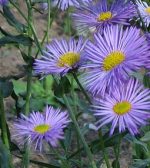 Showy fleabane, also called aspen or garden fleabane, is a herbaceous perennial native to open woods, prairies, meadows, and roadsides from Alberta and British Columbia, south to the Black Hills, New Mexico, Arizona and Oregon. It is a member of the aster family, Asteraceae, that also includes daisies, yarrow, and lettuce. The plant grows 20-30″ tall from a thick taproot and has a rosette of leaves and multiple flowering stems that are tinged with maroon and bear narrow leaves. The two inch wide flowerheads appear in early and midsummer and consist of numerous blue, purple, or rarely white ray flowers surrounding a mass of yellow disc flowers and are important to beneficial insects including bees. Plants are a good choice for the front of a border, as a groundcover, or in a meadow or wildlife garden. Many hybrids are available. The genus name, Erigeron, comes from the Greek words ἦρι (êri) meaning early referring to the early bloom tme, and γέρων (gérōn) meaning old man, referring to the hairy appearance of the fruit that resembles the beard of an old man. The specific epithet, speciosus, comes from the Latin word meaning showy or beautiful.
Showy fleabane, also called aspen or garden fleabane, is a herbaceous perennial native to open woods, prairies, meadows, and roadsides from Alberta and British Columbia, south to the Black Hills, New Mexico, Arizona and Oregon. It is a member of the aster family, Asteraceae, that also includes daisies, yarrow, and lettuce. The plant grows 20-30″ tall from a thick taproot and has a rosette of leaves and multiple flowering stems that are tinged with maroon and bear narrow leaves. The two inch wide flowerheads appear in early and midsummer and consist of numerous blue, purple, or rarely white ray flowers surrounding a mass of yellow disc flowers and are important to beneficial insects including bees. Plants are a good choice for the front of a border, as a groundcover, or in a meadow or wildlife garden. Many hybrids are available. The genus name, Erigeron, comes from the Greek words ἦρι (êri) meaning early referring to the early bloom tme, and γέρων (gérōn) meaning old man, referring to the hairy appearance of the fruit that resembles the beard of an old man. The specific epithet, speciosus, comes from the Latin word meaning showy or beautiful.
Type: Herbaceous perennial
Bloom: Two inch wide flowerheads consisting of numerous blue, purple, or rarely white ray flowers surrounding a mass of yellow disc flowers in early to midsummer.
Size: 20-30” H x 12-24” W
Light: Full sun; easily shaded out by taller plants.
Soil: Average, medium moist to dry, well drained
Hardiness: Zones 4-7
Care: Low maintenance
Pests and Diseases: None of significance
Propagation: Seeds need light but germination rate poor; division
Companion Plants: Sedum, Shasta daisy, Campanula, saxifrage, iceplant, blue fescue
Photo Credit: Wikipedia